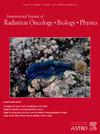Development of Multiparametric Prognostic Models for Stereotactic Magnetic Resonance Guided Radiation Therapy of Pancreatic Cancers
IF 6.4
1区 医学
Q1 ONCOLOGY
International Journal of Radiation Oncology Biology Physics
Pub Date : 2025-04-02
DOI:10.1016/j.ijrobp.2025.03.039
引用次数: 0
Abstract
Purpose
Stereotactic magnetic resonance guided adaptive radiation therapy (SMART) is a new option for local treatment of unresectable pancreatic ductal adenocarcinoma, showing interesting survival and local control (LC) results. Despite this, some patients will experience early local and/or metastatic recurrence leading to death. We aimed to develop multiparametric prognostic models for these patients.
Methods and Materials
All patients treated in our institution with SMART for an unresectable pancreatic ductal adenocarcinoma between October 21, 2019, and August 5, 2022 were included. Several initial clinical characteristics as well as dosimetric data of SMART were recorded. Radiomics data from 0.35-T simulation magnetic resonance imaging were extracted. All these data were combined to build prognostic models of overall survival (OS) and LC using machine learning algorithms.
Results
Eighty-three patients with a median age of 64.9 years were included. A majority of patients had a locally advanced pancreatic cancer (77%). The median OS was 21 months after SMART completion and 27 months after chemotherapy initiation. The 6- and 12-month post-SMART OS was 87.8% (IC95%, 78.2%-93.2%) and 70.9% (IC95%, 58.8%-80.0%), respectively. The best model for OS was the Cox proportional hazard survival analysis using clinical data, with a concordance index inverse probability of censoring weighted of 0.87. Tested on its 12-month OS prediction capacity, this model had good performance (sensitivity 67%, specificity 71%, and area under the curve 0.90). The median LC was not reached. The 6- and 12-month post-SMART LC was 92.4% [IC95%, 83.7%-96.6%] and 76.3% [IC95%, 62.6%-85.5%], respectively. The best model for LC was the component-wise gradient boosting survival analysis using clinical and radiomics data, with a concordance index inverse probability of censoring weighted of 0.80. Tested on its 9-month LC prediction capacity, this model had good performance (sensitivity 50%, specificity 97%, and area under the curve 0.78).
Conclusions
Combining clinical and radiomics data in multiparametric prognostic models using machine learning algorithms showed good performance for the prediction of OS and LC. External validation of these models will be needed.
胰腺癌立体定向磁共振引导放射治疗多参数预后模型的建立:胰腺癌SMART预后模型。
目的:SMART是不可切除PDAC局部治疗的新选择,显示出有趣的生存和局部控制结果。尽管如此,一些患者会经历早期局部和/或转移性复发,导致死亡。我们的目标是为这些患者建立多参数预后模型。方法和材料:纳入2019年10月21日至2022年8月5日期间在我院接受SMART治疗的所有不可切除PDAC患者。记录了SMART的几个初始临床特征和剂量学数据。提取0.35 T模拟MRI放射组学数据。将所有这些数据结合起来,使用机器学习算法构建OS和LC的预测模型。结果:纳入83例患者,中位年龄64.9岁。大多数患者有LAPC(77%)。中位OS为SMART完成后21个月,化疗开始后27个月。smart术后6、12个月生存率分别为87.8% [IC95% 78.2% ~ 93.2%]和70.9% [IC95% 58.8% ~ 80.0%]。使用临床数据的Cox PH生存分析是OS的最佳模型,其c指数IPCW为0.87。经12个月OS预测能力测试,该模型具有较好的预测效果(敏感性67%,特异性71%,AUC 0.90)。未达到中位LC。smart术后6和12个月LC分别为92.4% [IC95% 83.7% - 96.6%]和76.3% [IC95% 62.6% - 85.5%]。LC的最佳模型是使用临床和放射组学数据的成分梯度促进生存分析,其c指数IPCW为0.80。经9个月LC预测能力测试,该模型具有良好的性能(灵敏度50%,特异性97%,AUC 0.78)。结论:使用机器学习算法结合临床和放射组学数据的多参数预后模型对OS和LC的预测具有良好的性能。需要对这些模型进行外部验证。
本文章由计算机程序翻译,如有差异,请以英文原文为准。
求助全文
约1分钟内获得全文
求助全文
来源期刊
CiteScore
11.00
自引率
7.10%
发文量
2538
审稿时长
6.6 weeks
期刊介绍:
International Journal of Radiation Oncology • Biology • Physics (IJROBP), known in the field as the Red Journal, publishes original laboratory and clinical investigations related to radiation oncology, radiation biology, medical physics, and both education and health policy as it relates to the field.
This journal has a particular interest in original contributions of the following types: prospective clinical trials, outcomes research, and large database interrogation. In addition, it seeks reports of high-impact innovations in single or combined modality treatment, tumor sensitization, normal tissue protection (including both precision avoidance and pharmacologic means), brachytherapy, particle irradiation, and cancer imaging. Technical advances related to dosimetry and conformal radiation treatment planning are of interest, as are basic science studies investigating tumor physiology and the molecular biology underlying cancer and normal tissue radiation response.

 求助内容:
求助内容: 应助结果提醒方式:
应助结果提醒方式:


